Related Research Articles

The Junior Woodchucks of the World is a fictional scouting organization appearing in Disney comics and the DuckTales animated television franchise, most notably in adventures featuring Disney characters Huey, Dewey, and Louie as members.
Disney comics are comic books and comic strips featuring characters created by the Walt Disney Company, including Mickey Mouse, Donald Duck and Scrooge McDuck.
Bucky Bug is a beetle who appears in Disney comics. He first appeared in the Silly Symphony Sunday comic strip, and later appeared as a regular feature in the comic book Walt Disney's Comics and Stories.

Lady and the Tramp is a 1955 American animated musical romance film produced by Walt Disney and released by Buena Vista Film Distribution. It was directed by Clyde Geronimi, Wilfred Jackson, and Hamilton Luske, and features the voices of Barbara Luddy, Larry Roberts, Bill Thompson, Bill Baucom, Verna Felton, and Peggy Lee. The film was based on the 1945 Cosmopolitan magazine story "Happy Dan, the Cynical Dog" by Ward Greene, and tells the story of Lady the pampered Cocker Spaniel as she grows from puppy to adult, deals with changes in her family, and meets and falls in love with Tramp the homeless mutt.
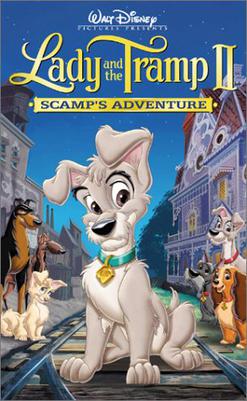
Lady and the Tramp II: Scamp's Adventure is a 2001 American animated direct-to-video musical romance film produced by Walt Disney Television Animation, and the sequel to Disney's 1955 animated feature film Lady and the Tramp. This film was released on February 27, 2001, 46 years after its predecessor in 1955. It involves Lady and Tramp's only son, Scamp, who runs away from his home and joins a gang of stray dogs. He also ends up in a romantic affair with one of the gang's members, Angel.
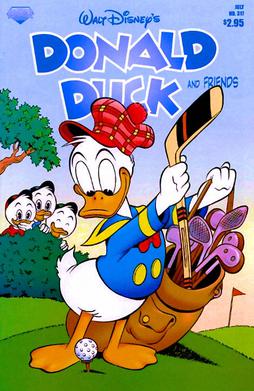
Donald Duck, also known as Donald Duck and Friends, is an American Disney comic book series starring the character Donald Duck and published by various publishers from October 1942 to June 2017. As with many early Disney comics titles, Donald Duck began as individual issues of Dell Comics' Four Color one-shots series. It was published as its own regular series in November 1952, starting with issue #26.
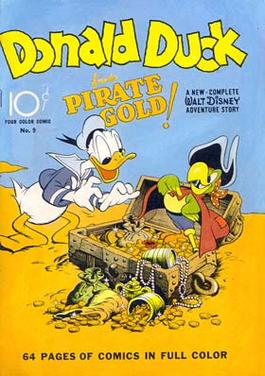
Four Color, also known as Four Color Comics and Dell Four Color, was an American comic book anthology series published by Dell Comics between 1939 and 1962. The title is a reference to the four basic colors used when printing comic books. The first 25 issues (1939–1942) are known as "series 1". In mid-1942, the numbering started over again, and "series 2" began. After the first hundred issues of the second series, Dell stopped putting the "Four Color Comics" designation on the books, but they continued the numbering system for twenty years.
William Crozier Walsh was a film producer, screenwriter and comics writer who primarily worked on live-action films for Walt Disney Productions. He was born in New York City. For his work on Mary Poppins, he shared Academy Award nominations for Best Picture with Walt Disney, and for Best Writing, Screenplay Based on Material from Another Medium with Don DaGradi. He also wrote the Mickey Mouse comic strip for more than two decades.
Walt Disney Comics Digest was one of three digest size comics published by Gold Key Comics in the early 1970s. The other two were Mystery Comics Digest and Golden Comics Digest. It was the first digest-sized regular Disney comic published in the US, and was very successful, offering relief from the company's slipping comic book sales.

Kalle Anka & C:o is a Swedish weekly Disney comics magazine, published by Egmont. The 52-page comic, launched in September 1948, is the overall best-selling Swedish comic magazine. In the early years, the comic printed translated stories from the United States, including Walt Disney's Comics and Stories, Four Color and other Dell Comics Disney titles. As Disney comics production waned in the United States in the 1960s, Kalle Anka began printing more European-produced content, from Scandinavia and Italy. Now, Kalle Anka & C:o and its Scandinavian sister editions Anders And & Co. (Denmark) and Donald Duck & Co (Norway) are identical, apart from the language.
Winnie the Pooh is a 1978-1988 daily comic strip based on the Winnie-the-Pooh characters created by A.A. Milne in his 1920s books. The strip ran from June 19, 1978, until April 2, 1988. This is one of many Disney comic strips that have run in newspapers since 1930.

Ward Greene was an American writer, editor, journalist, playwright, and general manager of the comic syndicate King Features Syndicate. He is known for overseeing the works of Alex Raymond and other writers and artists at King Features Syndicate, as well as writing Raymond's Rip Kirby comic strip from 1946 until his death.
Donald Duck is an American comic strip by the Walt Disney Company starring Donald Duck, distributed by King Features Syndicate. The first daily Donald Duck strip debuted in American newspapers on February 7, 1938. On December 10, 1939, the strip expanded to a Sunday page as well. Writer Bob Karp and artist Al Taliaferro worked together on the strip for more than 30 years. The strip ended in May 1995.
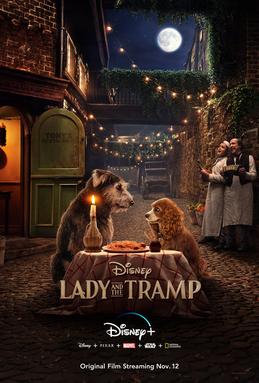
Lady and the Tramp is a 2019 American musical romance film directed by Charlie Bean and written by Andrew Bujalski and Kari Granlund, and produced by Walt Disney Pictures and Taylor Made, and distributed by Walt Disney Studios Motion Pictures. The film is a live-action/CGI hybrid remake of Walt Disney's 1955 animated film of the same name, which was based on the 1945 Cosmopolitan magazine story of "Happy Dan, the Cynical Dog" by Ward Greene. The film stars the voices of Tessa Thompson, Justin Theroux, Janelle Monáe, and Sam Elliott with the human characters portrayed by Thomas Mann, Kiersey Clemons, Yvette Nicole Brown, F. Murray Abraham, Adrian Martinez, and Ken Jeong. It is dedicated to storyboard artist Chris Reccardi, who died on May 2, 2019.
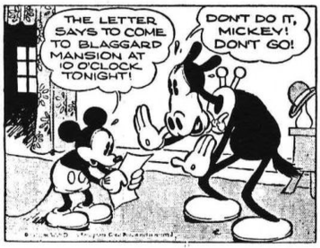
Mickey Mouse is an American newspaper comic strip by the Walt Disney Company featuring Mickey Mouse and is the first published example of Disney comics. The strip debuted on January 13, 1930, and ran until July 29, 1995. It was syndicated by King Features Syndicate.

Mickey Mouse Magazine is an American Disney comics publication that preceded the popular 1940 anthology comic book Walt Disney's Comics and Stories. There were three versions of the title – two promotional giveaway magazines published from 1933 to 1935, and a newsstand magazine published from 1935 to 1940. The publication gradually evolved from a 16-page booklet of illustrated text stories and single-page comic panels into a 64-page comic book featuring reprints of the Mickey Mouse and Donald Duck comic strips.
Silly Symphony, initially titled Silly Symphonies, was a weekly Disney comic strip that debuted on January 10, 1932, as a topper for the Mickey Mouse strip's Sunday page. The strip featured adaptations of Walt Disney's popular short film series, Silly Symphony, which released 75 cartoons from 1929 to 1939, as well as other cartoons and animated films. The comic strip outlived its parent series by six years, ending on October 7, 1945.
Disney Christmas Story is an American Disney comic strip that appeared each year in the weeks before Christmas, beginning in 1960. The strip ran Monday to Saturday for the three to four weeks leading up to Christmas Eve, and often promoted the latest Disney release or re-release. The strips were usually not published on the newspaper's comics page; they appeared at the bottom of the page somewhere else in the paper, so that the reader would have to hunt for it, and not-coincidentally pass by some of the Christmas advertising. The strip appeared every year until 1987.
Uncle Remus and His Tales of Br'er Rabbit is an American Disney comic strip that ran on Sundays from October 14, 1945, to December 31, 1972. It first appeared as a topper strip for the Mickey Mouse Sunday page, but after the first few years, almost always appeared on its own. The strip replaced the 1932-1945 Silly Symphony strip, which had spent its final year on gag strips featuring Panchito from The Three Caballeros.
Paperino e altre avventure, also known as Paperino giornale, is a 1937–40 weekly Italian Disney comics magazine published by Mondadori. The comic was launched by Federico Pedrocchi, Mondadori's art director, as a companion to the existing weekly Topolino magazine. Paperino published 149 issues from 30 December 1937 to 26 October 1940, at which point it was merged with Topolino.
References
- 1 2 3 Becattini, Alberto (2016). Disney Comics: The Whole Story. Theme Park Press. pp. 26–27. ISBN 978-1683900177.
- 1 2 3 4 Holtz, Allan (2012). American Newspaper Comics: An Encyclopedic Reference Guide. Ann Arbor: The University of Michigan Press. p. 342-343. ISBN 9780472117567.
- ↑ "Scamp Ad" . Retrieved 2013-10-17.
- ↑ Jim (31 May 2009). "Jim Fanning's Tulgey Wood: That Lovable Little Scamp". jimattulgeywood.blogspot.com.
- ↑ Markstein, Don. "Scamp," Toonopedia. Archived from the original on February 23, 2017.
- 1 2 "Scamp: Little Dog Gone". Inducks.org. Retrieved 10 August 2019.
- ↑ "Scamp: Bringing Home the Bacon". Inducks.org. Retrieved 10 August 2019.
- ↑ "Scamp: Just a Dream". Inducks.org. Retrieved 10 August 2019.
- ↑ "Scamp". Inducks.org. Retrieved 10 August 2019.
- ↑ "Scamp". Inducks.org. Retrieved 10 August 2019.
- ↑ "Scamp". Inducks.org. Retrieved 10 August 2019.
- 1 2 3 Becattini, Alberto (2016). Disney Comics: The Whole Story. Theme Park Press. p. 54. ISBN 978-1683900177.
- 1 2 3 Becattini, Alberto (2016). Disney Comics: The Whole Story. Theme Park Press. p. 75. ISBN 978-1683900177.
- ↑ "Lady and the Tramp II: Scamp's Adventure (film) - D23". d23.com. September 6, 2015.